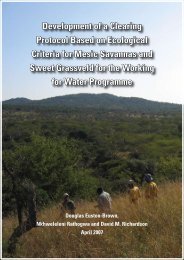Business Case forthe Pongola-Umzimkulu Catchment Management ...
Business Case forthe Pongola-Umzimkulu Catchment Management ...
Business Case forthe Pongola-Umzimkulu Catchment Management ...
You also want an ePaper? Increase the reach of your titles
YUMPU automatically turns print PDFs into web optimized ePapers that Google loves.
<strong>Business</strong> <strong>Case</strong> for the <strong>Pongola</strong>-<strong>Umzimkulu</strong> <strong>Catchment</strong> <strong>Management</strong> Agency<br />
When established, CMAs are expected to carry out their initial and inherent functions (as<br />
specified in Section 80 of the NWA). Apart from these functions, all other functions must be<br />
delegated or assigned to the CMA. As discussed above, the Minister may delegate or assign<br />
a wide range of additional powers and duties to a CMA, including those of a responsible<br />
authority (Chapter 4) and any of those in Schedule 3 of the NWA. This section sets out a<br />
generic phasing of the transfer of functions that should be used as a guideline in the<br />
development of a plan for the transfer of functions for each CMA.<br />
Three phases of the development of a CMA and the associated transfer of functions are<br />
envisaged, as described below.<br />
6.4.1 Phase 1: Developing relationships and legitimacy<br />
The first two years of the CMA’s existence are seen as being focused on developing<br />
administrative systems, developing a catchment management strategy, building<br />
relationships and building its profile amongst stakeholders in the WMA.<br />
During this period the CMA will be engaged in implementing its initial functions, such as<br />
development of the catchment management strategy and engagement with stakeholders<br />
and the delegation of functions will be minimal.<br />
Within the first two years, the following additional functions may be delegated to the CMA:<br />
• Involvement in water use registration and verification of water use<br />
• Advising and supporting licence applicants on the licensing process and requirements<br />
• Advising DWA on water use authorisations and licenses<br />
• Checking of water use against licence conditions and informing DWA of the results<br />
where compliance enforcement is required.<br />
• Validation of information submitted for registration.<br />
As an inherent function, CMAs should, during this phase, be responsible for determining<br />
their water user charges for abstraction uses, based on information provided by DWA in<br />
relation to registered water use and allocable water quantity.<br />
The CMA should also be responsible, during this phase, for verifying account information<br />
generated by DWA before the distribution of bills, and the managing of customer queries<br />
and customer care.<br />
6.4.2 Phase 2: Build capacity and consolidate<br />
The second phase will start after the CMS has been developed and will see an increase in<br />
capacity within the CMA and the undertaking of WRM functions as they have been<br />
prioritised in the CMS. Functions to be performed and delegated are outlined below:<br />
(i) Resource Directed Measures<br />
The NWA prescribes in chapter 3 that for all significant water resources, the class, reserve<br />
and resource quality objectives have to be determined as soon as reasonably practicable.<br />
S14 requires that all water management institutions give effect to these while executing<br />
their functions. During this second phase, the CMA should be in a position to determine<br />
these factors for water resources within the WMA that are not considered to be of national<br />
significance, and the relevant powers must be delegated to the CMA. All reserve<br />
Department of Water Affairs 27
















